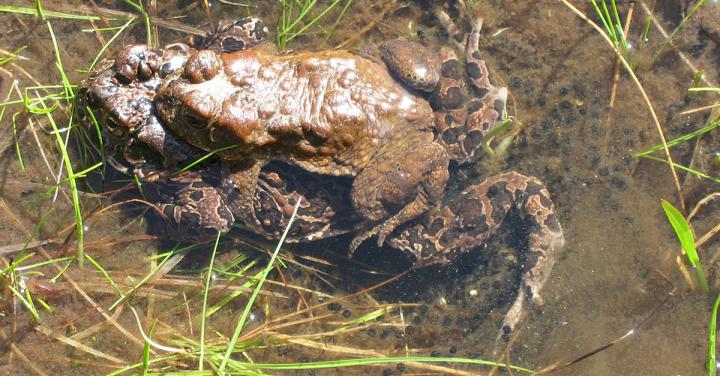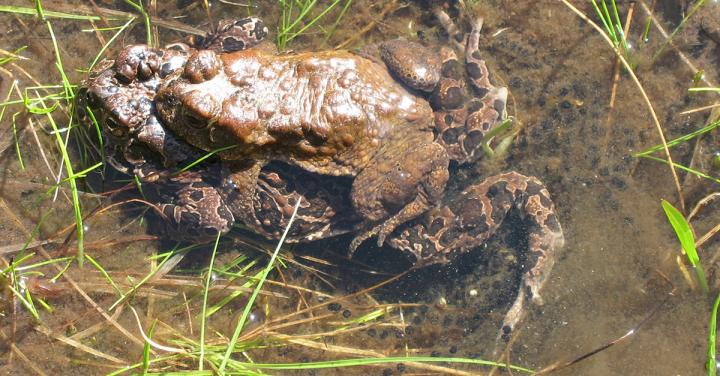
Credit: U.S. Forest Service
The Yosemite toad (Anaxyrus canorus) is a rare species found exclusively in California's Sierra Nevada. While its range encompasses hundreds of miles, spanning five national forests and two national parks, the livelihood and future survival of this federally threatened species may come down to mere centimeters.
According to research by the U.S. Forest Service's Pacific Southwest Research Station and its collaborators, for pools within alpine meadows to be suitable habitat for laying eggs and sustaining tadpoles, little things mean a lot.
"Our research looked at pools across the toad's range, in a variety of weather and precipitation conditions across a number of years," said Christina Liang, a research ecologist with the Pacific Southwest Research Station and lead author of the study. "But no matter the year-to-year variations, we found relatively consistent and definitive characteristics were shared by the majority of pools supporting Yosemite toad offspring compared to those unoccupied."
As the snow pack begins to recede across the Sierras, now is the time mating pairs of Yosemite toads seek out pools with the right mix of length and width, depth, vegetation and temperature to bring forth the next generation of toadlets. In Liang and her colleagues' study, "Fine-Scale Habitat Characteristics Related to Occupancy of the Yosemite Toad," they found the following differences, on average, between occupied and unoccupied pools:
- Depth of bottom debris: 1.62 cm (occupied) versus 1.69 cm (unoccupied)
- Pool vegetation height: 13.20 cm versus 14.16 cm
- Water depth: 4.35 cm versus 3.65 cm
- Water temperature: 24.82 degrees C (76.68 F) versus 21.75 degrees C (71.15 F)
- Percentage of surface water along the pool's width: 60.57 percent versus 40.07 percent
The patterns of occupancy were not necessarily surprising to researchers, but did verify that water depth, temperature and amount of surface water were significant predictors for a pool's suitability for Yosemite toad use.
"Relatively deeper, warmer and larger pools all contribute to quicker development of eggs and tadpoles," Liang said. "And while we don't fully understand the significance of the vegetation and detritus differences we observed, it could relate to other physical or chemical resources available in the pool that the toads need or prefer."
Yosemite toads only come together for about two weeks once a year in late spring to breed in shallow water areas located at elevations of 6,500 feet or higher in the Sierra Nevada. After toadlets emerge in the fall, it will take an additional three to six years for them to reach sexual maturity.
Researchers gathered their data by studying 143 pools across 19 meadows from 2005 to 2010 on the Sierra National Forest, Stanislaus National Forest and Yosemite National Park. Pools were surveyed three times a year to coincide with the various life stages of the toad: late spring for adult toads and eggs, early to mid-summer for tadpoles, and late summer for newly metamorphosed individuals. Researchers found when a previously occupied pool had less suitable characteristics the following year, that pool could go unused, which was a concern.
"Yosemite toads tend to be philopatric, meaning they typically return to the same pool year after year," Liang said. "So if a pool is no longer suitable, that means the toad has lost its prime breeding spot and the opportunity to reproduce."
This new understanding of microsite suitability, however, can provide land managers with valuable insights on how they can foster the species' future survival.
"Understanding the complexity of toad breeding habitat is critical to the conservation of the species," said Stephanie Barnes, an aquatic biologist on the Sierra National Forest, where 10 of the research meadows were located. "If you don't have the right kind of pool habitat for adults to select for breeding or to sustain the development of tadpoles through metamorphosis, it doesn't matter how hard you work to save the species."
While the specific cause of the Yosemite toad's decline is unknown, meadow restoration across the high Sierras is of importance to land managers focusing on watershed health to maintain clean and sustainable water supplies for the populations at lower elevations. Creating suitable breeding habitat for the Yosemite toad can be built into those restoration plans, Barnes said.
"Without this information, it's possible that a restoration project could do more harm than good for this species," Barnes said. "We want to create the right habitat for these toads wherever possible."
Liang and her research collaborators are working with land managers across the Yosemite toad's range to share their findings.
"We are sharing what we've learned so that the information can be applied to conserve this species," Liang said.
###
Headquartered in Albany, Calif., the Pacific Southwest Research Station develops and communicates science needed to sustain forest ecosystems and other benefits to society. It has research facilities in California, Hawaii and the U.S.-affiliated Pacific Islands. For more information, visit http://www.fs.fed.us/psw/.
USDA is an equal opportunity provider, employer and lender.
Media Contact
Paul Meznarich
[email protected]
707-825-2952
http://www.fs.fed.us/psw/
Original Source
https://www.fs.fed.us/psw/news/2017/20170620_yosemitetoad.shtml http://dx.doi.org/10.1643/CH-15-290
############
Story Source: Materials provided by Scienmag





